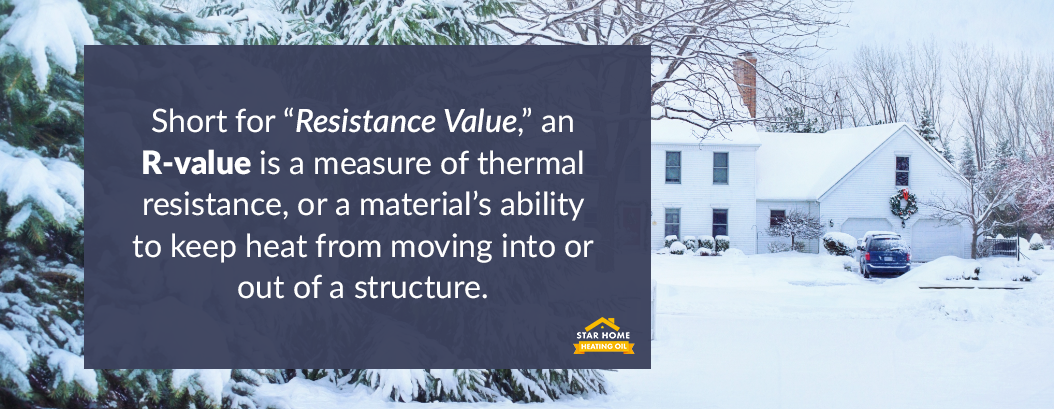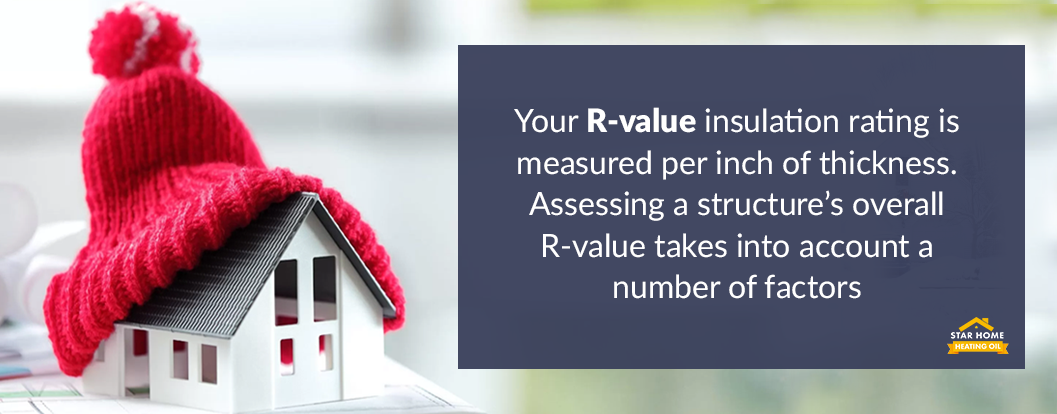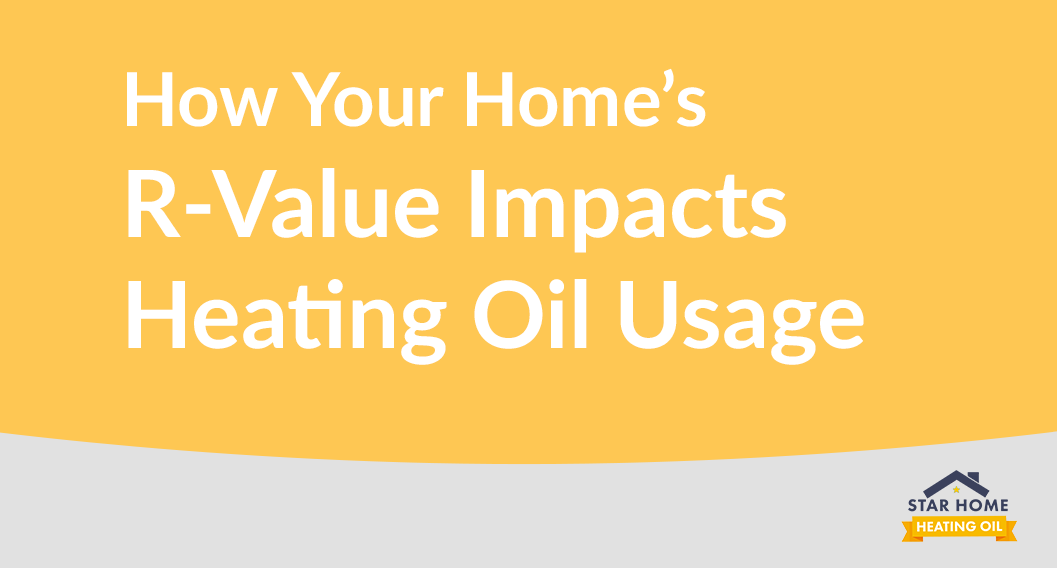How Your Home’s R-Value Impacts Heating Oil Usage
It’s hard to believe that winter officially began on December 21st because most homeowners in Nassau, Suffolk, Queens, Brooklyn, and Staten Island started firing up our heating oil furnaces back in October or early November. That means we had to square away heating oil delivery even earlier to get ahead of the game!
How Does Your Heating Oil Consumption Stack Up?
Do you ever wonder how your heating oil consumption compares with others? The lower temperatures and longer winters of the Northeast mean that we New Yorkers require more heating oil than our Southern counterparts. As a result, we begin consuming heating oil earlier in the autumn season and often continue doing so until well into the spring – just to keep our homes comfortable during unpredictable weather conditions.
Do you wonder how your household heating oil consumption stacks up with your neighbors? Is your furnace consuming less heating oil, about the same amount of heating oil, or does your furnace burn through so much of it that your heating oil delivery schedule is on par with your family’s pizza deliveries?
Why Am I Consuming More Heating Oil Than My Neighbors?
Through a little small talk with your neighbors, you discover that your furnace is burning more heating oil than theirs. You live on the same block, deal with the same temperatures, and your homes are almost equal in size. Your next-door neighbor even replaced his oil heat furnace the same year that you did….after all, you regularly compare notes about how you each perform regular maintenance according to the manufacturer’s guidelines. So, why are you ordering more heating oil delivery services than your neighbor?
Factors that Impact Heating Oil Consumption
Many factors impact your heating oil use and frequency of heating oil delivery. They include:
- The temperature outside
- Your desired temperature inside
- The length of the heating season (how many months you use your oil heat furnace per year)
- The age and condition of your oil heat furnace or oil heating boiler
- The energy efficiency of your home.
Home Construction and R-Value
While your and your neighbor’s houses may be similar, they could have been constructed quite differently, which can significantly impact your heating oil use and heating oil delivery requirements.
Let’s discuss the R-value. Short for “Resistance Value,” an R-value is a measure of thermal resistance, or a material’s ability to keep heat from moving into or out of a structure. This heat flow works both ways — we want to keep our homes cool in the summer and toasty and warm in the winter.

A building’s outer shell may be constructed with brick, wood, concrete, or other materials. All outer shells have a certain R-value, as does the insulation used to line the walls. Concerning insulation, R-values vary according to the type, thickness, and density of the material. The higher the number, the more insulating the material is. In other words, the better it is at retaining that heat flow or your desired room temperature —while minimizing your heating oil use.
Installing more insulation further increases your home’s R-value, and the amount that you need depends on a few factors:
- Your climate zone
- Your type of heating and cooling system
- Your desired level of insulation
- Building code requirements
R-Value Formula
R-value insulation rating is measured per inch of thickness. Assessing a structure’s overall R-value takes into account a number of factors and is determined by a complex mathematical equation which you can read about here. Others prefer to simply follow the insulation guidelines for their geographical region. For example, Nassau, Suffolk, Queens, Brooklyn, Staten Island, and the surrounding areas in New York mostly fall under the Region 4 climate zone.

Insulation Methods of Historic Homes
It’s hard to beat the distinctive beauty of a historic home, and the Northeastern United States is well-represented by them. Many homeowners are happy to call their mid-century modern, craftsman, Victorian, colonial, or revolutionary-era home their own!
One advantage of a historic home is its solid construction. Built with high-quality brick, stone, older-growth wood, and other materials, they were assembled with time-honored craftsmanship.
Having said that, older forms of insulation were not nearly as energy-efficient as the ones used today. Without energy improvements, that leaves some homeowners with the option of either cranking up the thermostat to burn more heating oil or simply bundle up to stay warm! Some of the insulating materials used in historic homes include:
- Mixed materials. Estimated R-value: .5 to 1. Homes of the early-to-mid 1800s were likely insulated with a variety of materials such as discarded paper, shredded textile, and hay and wood shavings. As you can imagine, these materials have a low R-value as they are not as efficient at resisting heat flow as more modern methods.
- Vermiculite. R-value: 2. This lightweight, shiny material emerged around 1920 and was used for soundproofing and insulation in homes and other structures. Resembling mica flakes, it absorbs moisture and is also fire-resistant and often poured between ceiling joists. Homeowners liked it for its energy efficiency which allowed them to use their heating oil more sparingly in comparison to older insulation methods. It is no longer used due to its asbestos content, a carcinogenic material known to cause mesothelioma.
- Mineral wool. R-value: 4. The 20th century brought innovation in home insulation materials. Formed into blankets, boards, or loose-fill insulation, mineral wool became popular before World War II and was made by spinning molten rock into balls of fiber.
Modern Insulation Methods
Technologies have allowed for safer and more efficient insulating materials in recent years. The most common forms of insulation used in new construction include:
- Loose-fill or blown-in insulation. R-value of 3.2 to 3.9. Made from small particles, this type of insulation is designed for retrofits and spaces that cannot accommodate blanket insulation. It is made from small particles of fiber, foam, or other materials.
- Blanket insulation (batts and rolls). R-value of 3.1 to R 4.3 per inch. Also called batt and roll insulation, this type of fiberglass insulation is placed between standard wall studs, rafters, or attic trusses. It is made from a combination of flexible fibers, most commonly fiberglass. You can also find rolls made from plastic, wool, cotton, or other natural fibers.
- Spray foam insulation. R-value of 3.5 (open cell) to 6 (closed cell). This form of insulation is ideal for reducing air leakage in small or awkward spaces. It can be blown into walls, attic surfaces, or under floors, where a lot of heat loss occurs. It comes in both open-cell, which allows some air and moisture to travel through, and closed-cell, which provides an air and vapor barrier.
- Foam board insulation. R-value of 3.8 to 8, depending on materials. These rigid boards are available in 2×9 or 4×8 sizes which can be cut and are often used in new construction.
As you can see, many factors contribute to a house’s overall R-value. If your neighbor’s furnace requires far fewer visits from a heating oil delivery service, it would be worthwhile to look for opportunities to better insulate your home.
Where Can I Add Insulation to My Home?
While you can’t easily swap out the insulation in your historic home’s walls, there are other things you can do to help preserve heat flow and conserve precious heating oil. The following additions can be performed by a qualified contractor or savvy DIY warrior.
- Attic insulation. Since heat rises, a substantial amount of heat loss occurs in the attic. You can mitigate some of this heat loss by applying fiberglass batt insulation between the rafters. An insulation rated a minimum of R-60 is recommended in the Northeast.
- Walls. For added insulation, you can dense-pack cellulose into a wall cavity up to an R-value of 21. Most older homes can accept up to R-14 insulation into the wall cavity without major retrofitting required.
- Floors. The ceiling of a crawl space or basement is another common area of heat loss. In this region, it should have an R-value between 30 and 38. A good choice of insulation is a closed-cell spray foam which helps mitigate moisture and create an air seal.
- Windows. Replacing single-paned historic windows with energy-efficient vinyl windows can dramatically reduce drafts and therefore help conserve your heating oil. In the short term, sealing cracks on the sash and border with a caulk designed for windows can help minimize heat loss.
- Water heater/pipes. By insulating your water heater or pipes, you can reduce standby heat loss by up to 45 percent, lowering your heating oil consumption.
The Star Home Heating Oil Advantage
At Star Home Heating Oil we understand that a family’s budget needs to stretch as far as it can. This is why we have dedicated our business to providing New York state homeowners in Long Island, Nassau, Suffolk, Brooklyn, and Queens with a platform to shop for the best heating oil prices from pre-vetted, reputable heating oil delivery companies in one convenient system. This means that customers like you no longer need to call around, haggle, or wait for price quotes for heating oil delivery. Instead, you’ll get matched with the lowest price we can find from local professional heating oil companies with whom we have established relationships.
Look up today’s NY fuel oil prices with ease. Book your home heating oil delivery today!


